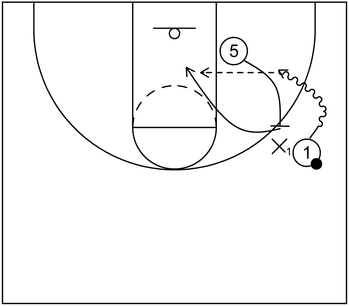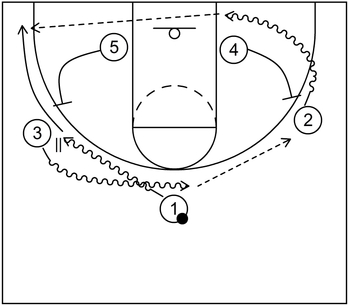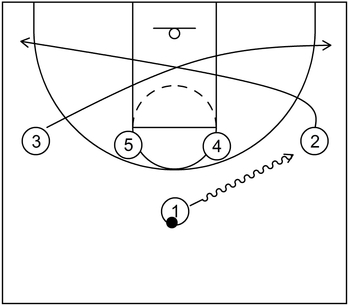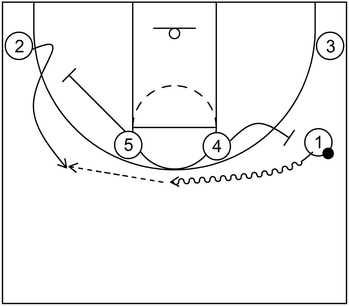Basic definition of the step-up screen
The step-up screen features action that occurs when an offensive player cuts to an area away from the middle of the court, typically near a wing or slot, usually with their back towards the adjacent baseline to set an on-ball screen for another offensive player who currently has possession of the basketball.
Types of basketball players who could set the step-up screen
The step-up screen is typically set by a post player such as a power forward or center for a perimeter player such as a point guard, shooting guard, or small forward.
However, it is possible for a perimeter player to set this particular on-ball screen for another perimeter player. Furthermore, in certain instances, a perimeter player could set an inverted step-up screen for a post player.
Essentially, this type of basketball screen could be set or utilized by any number of basketball positions, which would ultimately depend on coaching philosophy as well as basketball offense strategies that are suitable to team personnel.
Basic examples of the step-up screen
Example 1

This is a basic example that demonstrates a common version of the step-up screen set. Essentially, 5 sprints towards the right slot to set the step-up screen for 1.
Additionally, 5 can set the step-up screen at an angle that influences X1 to fight over the top of the screen as opposed to going under it.
From there, 1 could use the screen, dribble towards the basket, and score via a layup or dunk.
Example 2

This is another basic example of this step-up screen. This time, however, 5 sets the step-up screen at a more flatter angle.
Normally, this would allow 1 to dribble towards the left or right side of the court. Nevertheless, for this instance, 1 dribbles towards the right. Following that, 1 could simply attempt to score near the perimeter by taking a mid-range jump shot.
Example 3

This is a basic example of the step-up screen that occurs while the player in possession of the ball is near the right side wing area.
Essentially, 1 uses the step-up screen and following that, 5 simply rolls to the basket. Afterwards, 5 could receive the ball from 1 and score at the rim with a layup or dunk.
Example 4

This is another basic example of the step-up screen. This time, though, the defender guarding 5, which is X5, utilizes a defensive hedge, particularly a soft hedge, to slow down the dribble penetration of 1.
However, to counter the hedge action, 5 could pop to an open area near the right side high post elbow after setting the screen.
Next, 5 could receive the ball from 1 via a pocket pass and then, 5 could take the mid-range jump shot for a quick hitting scoring opportunity.
Example 5

This is an example of the step-up screen that is slightly more advanced than the previous iterations. For this case, 5 initially cuts towards 1 to set the step-up screen.
However, as that happens, X5 jumps above 5 with a hard hedge to completely cut off baseline dribble penetration for 1.
Therefore, as 1 begins to dribble towards the baseline, 5 could quickly slip the screen and cut to the basket as a counter to the hedge action. After that, 5 could receive the ball from 1 and score at the rim.
Example 6

This is an example of the step-up screen by way of basic action that is somewhat similar to the pistol offense. To start, 1 dribbles towards the right side wing via the step-up screen set by 2.
Following that, 2 cuts to the top via the screen set by 5, which also completes screen the screener action. Afterwards, 2 could receive the ball from 1 and take the open three-point jump shot.
Affiliate Disclosure: I may earn a commission on qualifying purchases made through the links below.
Examples of basketball plays that feature the step-up screen
Example 1

This is an example of a quick hitting basketball play that utilizes the step-up screen to create a three-point scoring opportunity, particularly for the offensive team’s point guard.
To start, 1 executes a dribble handoff with 3 near the left side wing area. Next, 3 dribbles back toward the top and then, 2 receives the ball from 3.
After that, 2 dribbles toward the baseline via the step-up screen set by 4. As that happens, 1 cuts from the left side wing to the left side corner by way of the hammer screen set by 5.
From there, 1 could receive the ball from 2 via the baseline drift pass. Following that action, 1 could take the open three-point jump shot.
Example 2

This is an example of a basketball play that includes step-up screens, which then lead to one or more scoring opportunities.
To begin, 4 steps out of the low post area to set a step-up screen for 1. However, 1 rejects that screen and instead, dribbles towards the right side high post elbow area.
As that occurs, 2 cuts to the left side wing via a flare screen set by 3. Afterwards, 2 could dribble towards the left side baseline area via the step-up screen set by 5.
From there, 2 could take the mid-range jump shot if that is open. Alternatively, as 2 dribbles toward the baseline, 4 could cut to the basket, receive the ball from 2, and score at the rim.
Example 3

This is an example of a basketball play that utilizes the step-up screen as well as additional offensive actions that could lead to multiple scoring options.
To start, 1 dribbles toward the right side wing via the flattened step-up screen set by 5. Next, 5 rolls to the basket but for this case, it is decoy action to occupy the defense.
Afterwards, 1 dribbles toward the high post area via the side ball screen set by 4. Also, 4 pops to the right side corner after setting the side screen.
From there, 4 could receive the ball from 1 and take the three-point jump shot if open.
Alternatively, 2 could receive the ball from 1 and immediately after that 5 could fill the left side low post block. Once that occurs, 5 could receive the ball from 2 and score by way of a low post move near the basket.
Example 4 – Part 1

This is an example of a basketball play that utilizes the step-up screen, initiated from a 1-4 high set.
It is also based on insights within Great Pick and Roll Plays by Lason Perkins.
To start, 1 executes a dribble entry towards the right side wing and as that occurs, 2 cuts across the lane to the left side corner while 3 cuts across the lane as well to the right side corner.
Example 4 – Part 2

Next, 1 dribbles toward the top via the on-ball side screen set by 4. Also, as that happens, 2 cuts to the left side wing area via the wide pin down screen set by 5.
Example 4 – Part 3

Following that, 2 dribbles toward the baseline via the step-up screen set by 5. Additionally, 5 rolls to the basket after the screening action occurs.
From there, 5 could receive the ball from 2 and score near the rim via a layup or dunk. Alternatively, 2 could take the mid-range jump shot if that is open.
Example of the step-up screen used in transition offense

This is an example of the step-up screen being utilized within transition offense. For this situation, it is assumed that the opposing team took a jump shot but missed it.
Therefore, the defensive rebound was gathered by 4. Following that, to begin the action, 1 receives the ball from 4. As that occurs, 5 quickly runs to the rim while 2 and 3 begin to sprint towards the corners.
However, 2 receives the ball early from 1 via a pitch ahead pass. As that happens, this triggers a step-up screen by 5 near the extended right side wing area.
Afterwards, 2 uses the screen and dribbles toward the baseline. At the same time, 5 rolls toward the lane as well. Next, 2 could dribble all the way to the basket and score at the rim.
Alternatively, 5 could receive the ball from 2 and score with short-range jump shot or floater within the lane.
Additionally, as another scoring option, 3 could receive the ball from 2 via the drift pass and take the three-point jump shot if that is open.
Potential benefits of utilizing the step-up screen
The step-up screen could be a potentially beneficial action for the offensive team because it is simple to implement and it could lead to quick scoring opportunities near the basket or around the perimeter areas of the court.
Essentially, the offensive player in possession of the ball could use the step-up screen to dribble towards the baseline and then possibly score at the rim or by way of a mid-range or three-point range jump shot.
Alternatively, the offensive player who set the step-up screen, also known as the screener, could receive the ball from the offensive player that initially had possession of it and then potentially score as well.
Furthermore, the step-up screen could also lead to potential scoring opportunities for additional offensive players, particularly on the weak side, who were not involved in the initial screening action.
In addition to that, the step-up screen could be utilized within transition offense (as shown in an example earlier) before the defensive team is fully prepared to properly hinder the screening action with ball screen tactics such as the defensive hedge, the drop coverage, or ice defense.